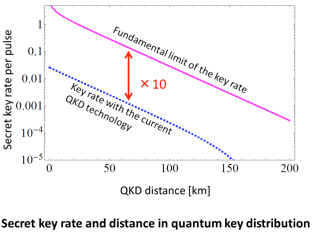The National Institute of Information and Communications Technology (NICT, President: Dr. Masao Sakauchi), in collaboration with Raytheon BBN Technologies (BBN) and Louisiana State University (LSU), have proven a fundamental tradeoff between the secret key generation rate and the channel loss for point-to-point optical quantum key distribution (QKD). QKD is a new emerging technology of cryptography which is provably secure against any possible deciphering attacks (the security does not rely on the eavesdropper’s computational powers and the protocol is even secure against any future technologies such as quantum computers). The key generation rate limit proved here suggests that there is still room to improve the key rate of currently existing QKD systems at least ten times while the fundamental rate-loss scaling limit will severely limit the future performance of the point-to-point QKD systems. The result provides key aspects on further developments of current QKD technologies as well as future technologies beyond point-to-point QKD such as quantum repeaters.
The result was published in Nature Communications on October 24, 2014.

























